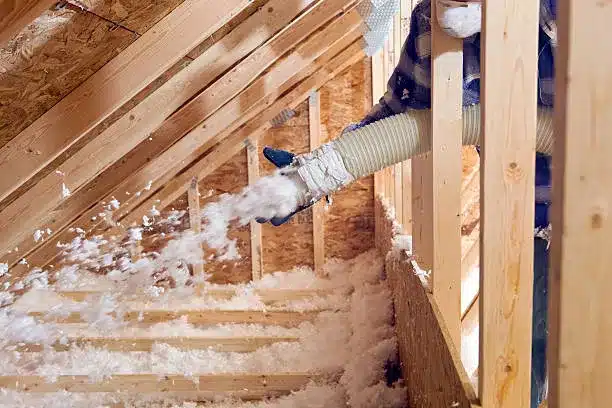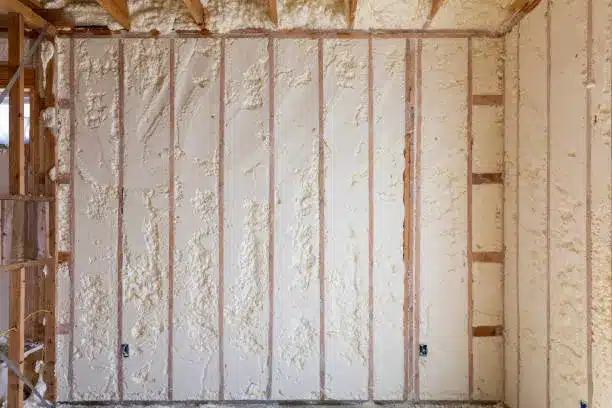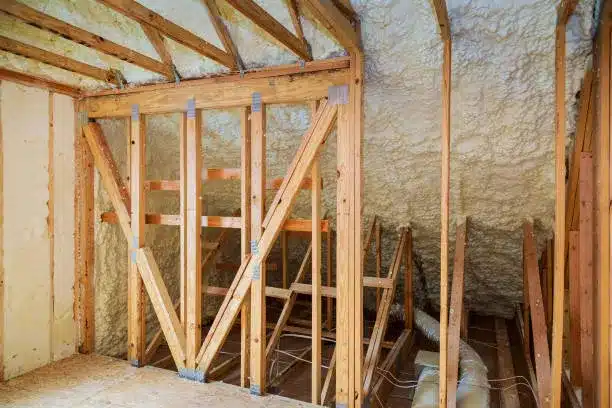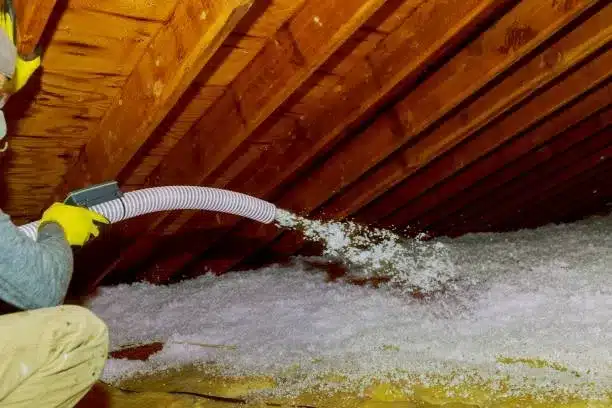Blown-in insulation is ideal for attic upgrades because it fills irregular spaces with minimal gaps, delivers consistent thermal performance, and can be installed with limited structural disruption. Its loose-fill composition adapts to joists, wiring, and framing, ensuring better coverage than many batt-style alternatives. For attics in older or remodeled homes, this type of insulation allows effective improvement without removing existing materials.
Blown-in insulation is also efficient in cold and mixed climates, where attic insulation has a direct impact on HVAC performance and heating costs. According to the U.S. Department of Energy, proper attic insulation can reduce heating and cooling expenses by 10% to 50% (DOE, 2023).
All Foam & Insulation, LLC brings field-tested expertise with insulation systems across Oregon’s diverse weather zones. The insights here reflect actual installation performance and material behaviors observed over time.
Key Advantages of Blown-In Insulation
Blown-in insulation combines thermal resistance with adaptability. It minimizes energy loss and improves attic performance without requiring structural changes. Compared to other materials, it offers:
Comparison Table: Blown-In vs Other Attic Insulation Types
| Feature | Blown-In Insulation | Fiberglass Batt | Spray Foam (Open-Cell) |
|---|---|---|---|
| Material Coverage | High, fills gaps & cavities | Moderate, pre-cut sections | Very High, seals air leaks |
| Air Sealing Capability | Moderate | Low | High |
| Moisture Resistance | Depends on material type | Low | Moderate (vapor permeable) |
| Installation Speed | Fast | Moderate | Slower |
| Disruption to Structure | Minimal | Minimal | Higher |
| Cost Efficiency | High | Moderate | Higher |
| Retrofit Suitability | Excellent | Moderate | Limited |
| Sound Dampening | Good | Moderate | High |
Bonus Tip: Cellulose blown-in insulation provides better sound absorption and higher recycled content than fiberglass options.
Technical Specifications and Performance Data
| Property | Blown-In Cellulose | Blown-In Fiberglass |
|---|---|---|
| R-Value per Inch | 3.2 – 3.8 | 2.2 – 2.7 |
| Fire Resistance | Treated for flame retardancy | Non-combustible |
| Vapor Permeability | Moderate | Low |
| Settling Over Time | Up to 20% (cellulose) | Minimal |
| Recycled Content | Up to 85% | ~25-35% |

Why Attic Performance Matters in Oregon Homes
Oregon experiences cold winters, wet conditions, and mixed-climate transitions. Attic insulation helps prevent heat escape, moisture buildup, and ice damming. Poor insulation leads to uneven temperatures, overworked heating systems, and higher utility bills.
Blown-in insulation is especially suitable for:
- Older homes with inconsistent joist spacing
- Attics with obstructions like wiring or ductwork
- Retrofits where batts or foam are impractical
Pacific Northwest homes often need vapor-permeable but dense insulation. Cellulose blown-in types help manage both thermal retention and humidity fluctuation without trapping moisture.
Bonus Tip: For Oregon’s damp conditions, air sealing prior to blowing in insulation prevents condensation-related damage.
For a deeper look at our service expansion and insulation innovations, read more about our blown-in insulation services for Oregon properties
Things to Consider Before Making a Decision
- Current Attic Condition: Check for mold, roof leaks, or structural gaps before installation.
- Material Type: Fiberglass offers less settling; cellulose offers more recycled content and soundproofing.
- Air Sealing Needs: Air leaks reduce insulation effectiveness. Always pair blown-in insulation with proper air sealing.
- Weight Load: Some attics may have weight limits. Cellulose is heavier than fiberglass.
- Moisture Management: Blown-in products should never be used as a vapor barrier.
Closely Related Services from All Foam & Insulation, LLC
These services complement attic insulation upgrades and support energy efficiency improvements:
- Blown-In Insulation Loose-fill application that conforms to attic cavities and irregular framing.
- Fiberglass Batt Insulation Pre-cut panels suitable for accessible attics and new construction.
- Closed-Cell Spray Foam High-performance insulation that provides air sealing and vapor barrier capabilities.
- Open-Cell Spray Foam Expands rapidly to fill cavities; suitable for sound dampening and flexible installations.
Common Questions Before Upgrading Your Attic Insulation
Is blown-in insulation enough on its own?
In many attics, yes. When properly installed and paired with air sealing, blown-in insulation meets recommended R-values and minimizes heat loss.
How long does it take to install blown-in insulation?
Most attic installations can be completed within a few hours, depending on size and access.
Can I add blown-in insulation over existing insulation?
Yes. It works well as a top-off layer over old fiberglass batts.
Will insulation settle or shift over time?
Cellulose may settle up to 20%, but installers can overfill slightly to compensate.
What if there’s existing rodent damage?
Old insulation should be removed and the space sanitized before adding new material.
Get Expert Insulation Guidance
Contact All Foam & Insulation, LLC for help assessing your attic and selecting the right insulation method for Oregon’s climate. Installation teams have field-tested experience with both retrofit and new construction projects.
Phone: (541) 826-9600
Email: [email protected]
FAQ About Blown-In Insulation
What’s the typical lifespan of blown-in insulation?
It lasts 20 to 30 years, depending on material type and attic conditions.
Does blown-in insulation affect ventilation?
Not directly, but it must not block soffit vents or air pathways.
Can blown-in insulation be removed easily?
Yes, using industrial vacuums. This is typically done during major upgrades or repairs.
What R-value should my attic have in Oregon?
R-38 to R-60 is the DOE-recommended range for this climate zone.
Is it safe to stay in the home during installation?
Yes. Installers use hoses from outside, and modern materials produce minimal airborne dust.





